How to Illustrate a Children’s Book: Revise the Sketches (Part 3)
WRITTEN BY ABI CUSHMAN
 In my previous articles in this How To Illustrate a Children’s Book series, I talked about my process for making thumbnails and making the initial dummy for The Quiet Forest, written by Charlotte Offsay. Now I’m going to share the ever-so-daunting REVISION stage.
In my previous articles in this How To Illustrate a Children’s Book series, I talked about my process for making thumbnails and making the initial dummy for The Quiet Forest, written by Charlotte Offsay. Now I’m going to share the ever-so-daunting REVISION stage.
In the story, a mischievous mouse starts a chain of events, in which each forest animal gets disrupted, and then in turn, disrupts another.
My goal in the first sketches was to figure out what activity each animal was doing when they got disrupted, and how best to handle the scenes of increasing chaos.
Step 5: Revise the sketches based on editor/art director feedback
So, what did the art director and editor think of my initial ideas?
My ideas for the animals’ activities: Mostly approved!
Example: I thought the mouse could swing on a vine and splat into a rabbit’s stack of pancakes.
Initial Sketch:

Final Sketch:

So you can see in the revised sketch, I added more action to the scene, but the activity of the mouse landing in the rabbit’s pancakes remained the same.
My ideas on how to lay out the scenes of chaos: Mostly scrapped and reworked!
Example: My initial layouts had a vignette (spot illustration) paired with a single full page scene. This was changed for the most part into a full double page spread or two full single page illustrations. We also changed the book dimensions from a vertical orientation to a landscape orientation.
Initial Sketch:

Final Sketch:

So you can see a big difference in the layout and page orientation for this spread. I really like how dynamic the chaotic scenes became with these changes. Interestingly, many of the spreads toward the end of the book ended up being very similar to my original thumbnails.
Other change that I was not involved in: Simplifying the sound word text so it didn’t repeat. Eg: “Splat. Thump! Splat. Thump!” became just one “Splat. Thump!” This was a change the editor talked about with Charlotte, the author.
This sketch revision process took a few months of going back and forth with the editor and art director. And toward the final stages, they looped in Charlotte for her feedback.
So if you’re nervous about this stage in the process, it’s okay. Getting feedback can be overwhelming sometimes. But remember that the editor and art director are both trying to make the book the best it can possibly be. You’re all working toward the same goal.
What I like to do after getting feedback is to take a step back and figure out what the feedback is really saying. If the editor or art director wants to change something, it means the way you have it isn’t working. But, you can always suggest your own solutions! Making a book is a very collaborative process, and it’s good to approach the revision stage with an open mind.
In my next article, I will share how I made the final art!
More Illustration Tips
- How to Illustrate a Children’s Book: Getting Started (Part 1)
- How to Illustrate a Children’s Book: Make a Picture Book Dummy (Part 2)
- How to Illustrate a Children’s Book: Make the Final Art (Part 4)
- Make Your Children’s Book Illustration Portfolio Unforgettable
Share this Article:
